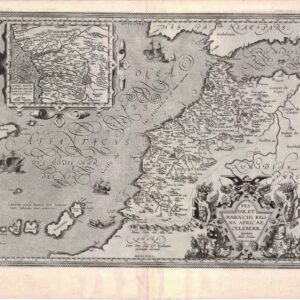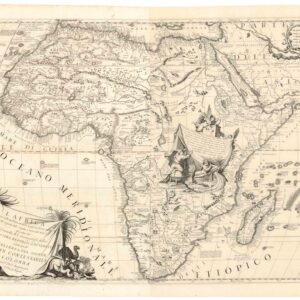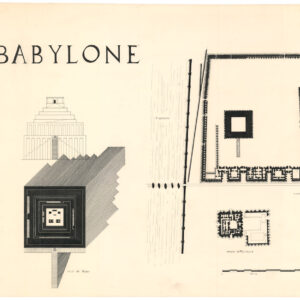One of the great North African tourist maps to grow out of the Victorian obsession with the Orient.
Plan de Carthage & de ses ruines
$575
1 in stock
Description
This rare and visually-enticing map of ancient Carthage is wonderfully evocative of what exploring these great archaeological sites must have been like in the early 20th century. Being a folding map printed on thick paper and measuring a manageable 74 by 54 cm, this was an ideal way-finder for the more adventurous tourist. The map not only invites both actual and potential visitors to the site for a tour of the ruins, but also provides contacts to various tourist-related services by way of a mosaic of local advertisers on the verso. It was published in 1930 by the Comptoir National d’Escompte de Paris, a large public limited company with offices throughout the colony of Tunisia. It was therefore issued in both Paris and Tunis. Whether you were planning a visit from the comfort of home back in France, or you serendipitously found yourself in Tunis with an opportunity to visit the ruin fields of one of the greatest cities in history, this map provided everything you might need.
The map itself constitutes a rather beautiful graphic composition, which situates the extensive ruin fields of ancient Carthage within the wider context of an early 20th century landscape. At the heart of our map we find the many Carthaginian (also known as Phoenician or Punic), Roman, and Early Christian ruins interspersed with elements of modernity. These include railway stations, asphalted roads, hotels, and the local police station. All of the major ruins known at the time have been identified and labeled individually, many of them even being depicted in detailed plan drawings, revealing that even at this early stage, archaeology played an important role in understanding and explaining the ruins. Among the famous Carthaginian landmarks we find the Antonine baths and Roman cisterns, the amphitheatre and odeon, two large Roman necropolises, as well as numerous early basilicas and homes of wealthy merchants and other important personages of the city. In the upper left of the map we even see the outline of the city’s great Hippodrome or race track.
From an archaeological point of view, a number of characteristics stand out and make this map particularly enticing to study. Along the coast, seemingly haphazard lines have been drawn to indicate the extensive ruin fields that lay submerged in the bay. Carthage was above all a city made great by trade and the Phoenicians dominated Mediterranean commerce in one way or another for almost a millennium. In the ninety years that have passed since the publication of this map, archaeologists have conducted extensive investigations of Carthage’s impressive harbor facilities and today visitors can glean a little more about just how great a port city this once was. In 1930, however, all that most laypeople had to go by was their imaginations, stimulated by Polybius’ tales of the Punic Wars, the occasional wall protruding from the waters of the bay, or by the early archaeological indications provided on maps such as this one.
In general, the remaining structure of the town is suggestive of the type a classical city that was either built by or heavily inspired from Roman urban traditions. While Carthage had a much older form that dates back to the early Iron Age, the city was extensively rebuilt following its sacking and subjugation by Roman forces in 146 BCE. This saw the introduction of an urban grid plan, as well as important urban institutions. Despite more than 2000 years having passed and Carthage gradually growing into a modern coastal town, the core elements of the ancient city still stand out clearly. From the plan itself, we get a sense of the orthogonal layout of the city. Its grid extends palpably north-south to and from the shore, and east-west along the coastline.
At the heart of the map we find the dominant thoroughfares of Avenue Roustan/Avenue du Cardinal Lavigerie on one hand, and Avenue des Thermes/Avenue de Theatre Romain on the other. These correspond to the main north-south thoroughfares that structure any Roman provincial city and are known as a cardo maximus. With this infrastructural spinal column in place, the urban grid of a Roman city could unfold. The fact that such thoroughfares were modernized over time and continue in use even millennia later is not at all unusual, but normally it is not the case that these streets remain lined with the original monumental colonnades with which the Romans framed them. In the case of Carthage, it is not only the colonnaded streets that give away the ancient origins of the plan, but also their explicit function of connecting the harbor front with the Classical city’s major institutions (essentially the main Temple Square or temenos).
In the upper right corner of the map we find a small inset of the region surrounding Carthage, in particular how it relates to the capital of Tunis and the large lagoon fronting it. In the legend of the inset, the various means of traveling between Carthage and Tunis that are indicated on this smaller map have been explicated in writing and provided with a price. Options essentially consist of road or railway travel between the two.
Ultimately, this is one of the most charming, historically accurate, and time-typical maps of an archaeological site that you can get your hands on today. It constitutes an original, albeit colonial view of one of the greatest cities in history, one that played a great role in the formation of the Roman Empire, and consequently of Judeo-Christian civilization in general.
A note on the mapmakers
While the map clearly denotes both the printer/publisher, as well as the mapmakers, we have unfortunately not been able to identify these chaps with any certainty. Under the main title cartouche on the map, E. Cyrino & A. Jacquemoud are indicated as editeurs. It is possible that A. Jacquemoud is Antoine Jacquemoud, a 19th century French doctor, politician, and revered poet operating in the Italian-French borderlands of Savoy. Though what his relation to Tunisia and Carthage is, remains unclear to us. Similarly, we have not been able to identify E. Cyrino, beyond his role in compiling this map.
Cartographer(s):
Condition Description
Excellent. Folding map on thick paper. Minor blemishes.
References



